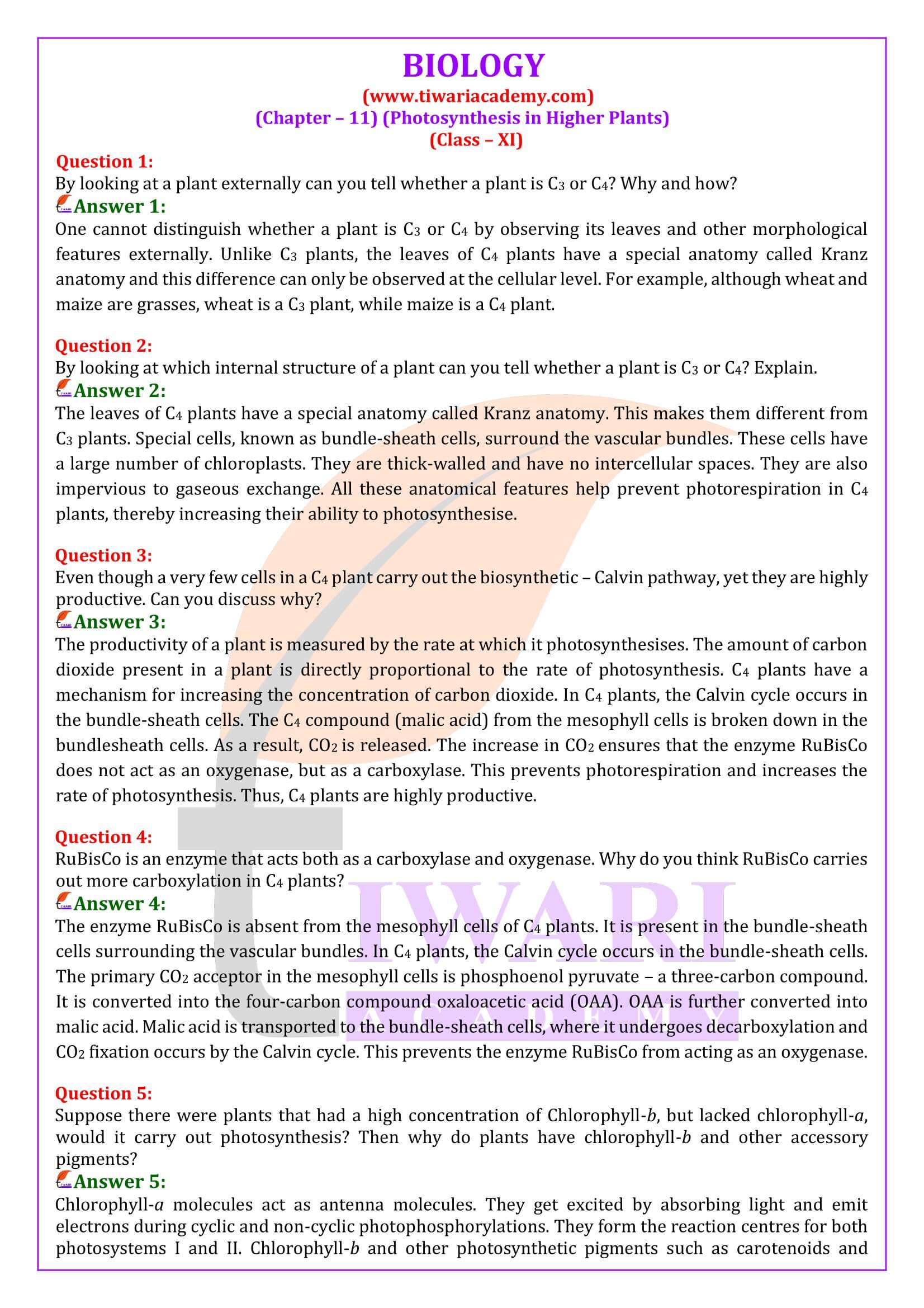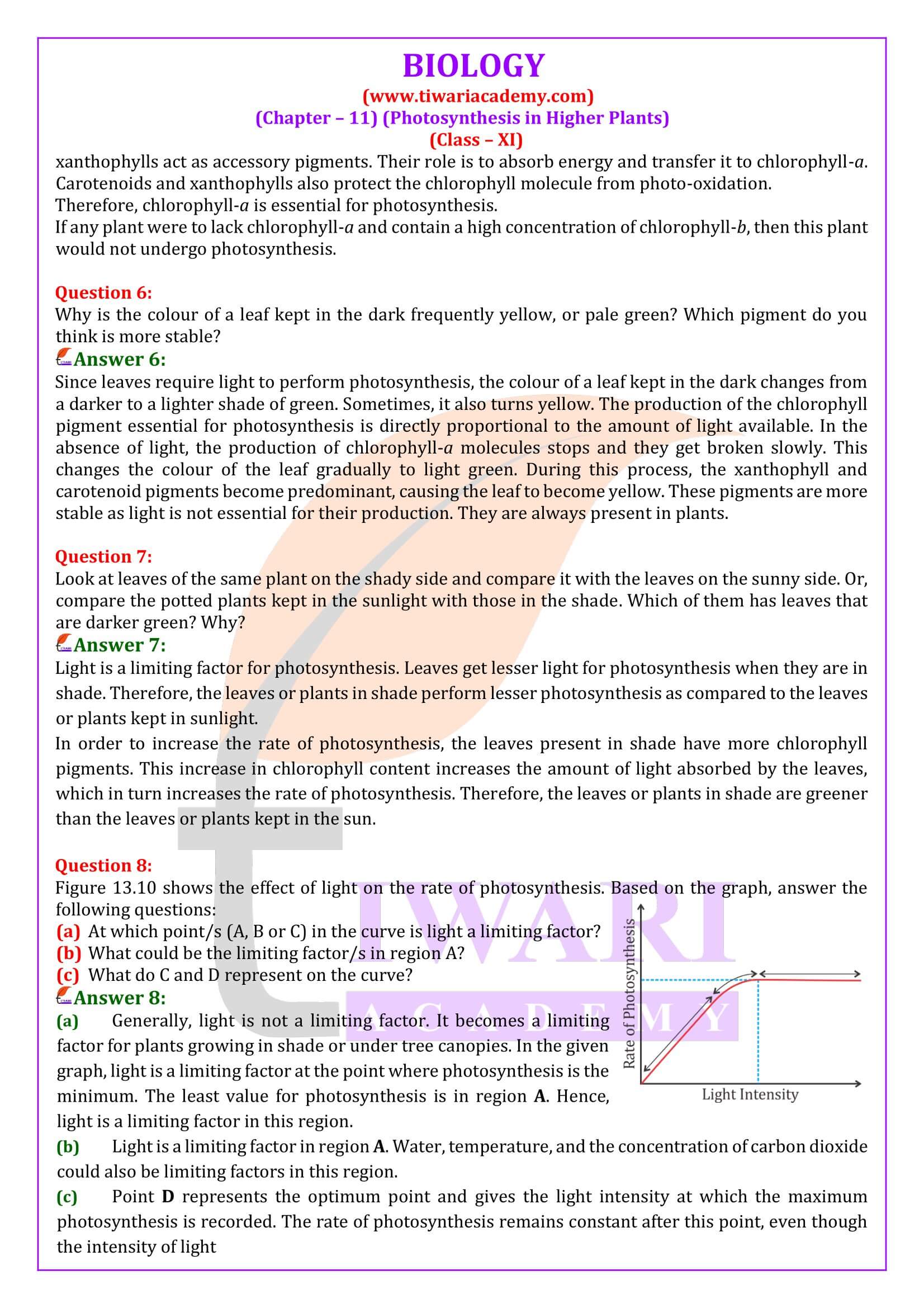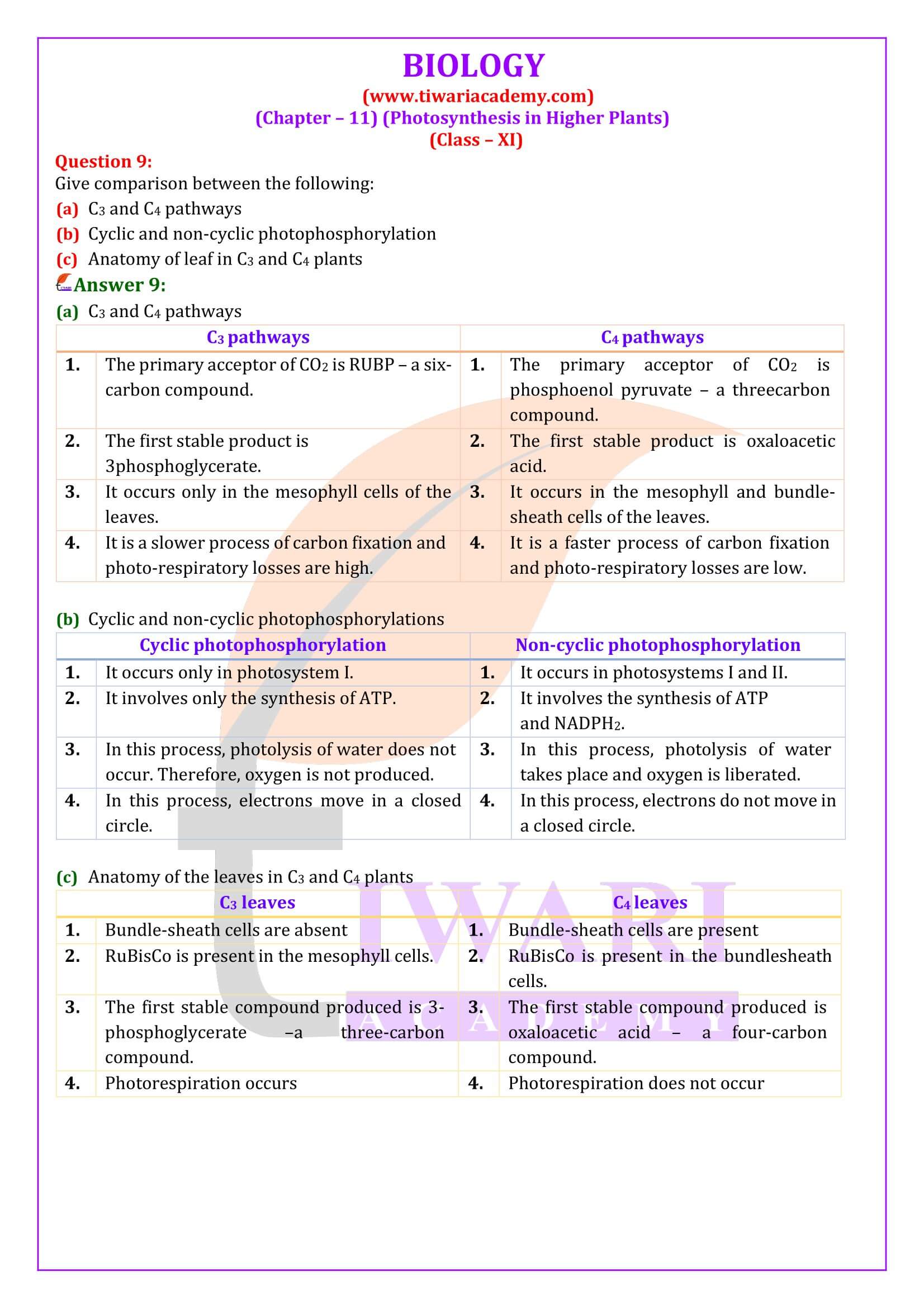NCERT Solutions for Class 11 Biology Chapter 11 Photosynthesis in Higher Plants in Hindi and English Medium to Study online or download in PDF format free updated for new academic session 2025-26. NCERT Solutions and NCERT Books are also given to download in PDF. If you have some query about CBSE or NCERT, please join the Discussion Forum here.
NCERT Solutions for Class 11 Biology Chapter 11
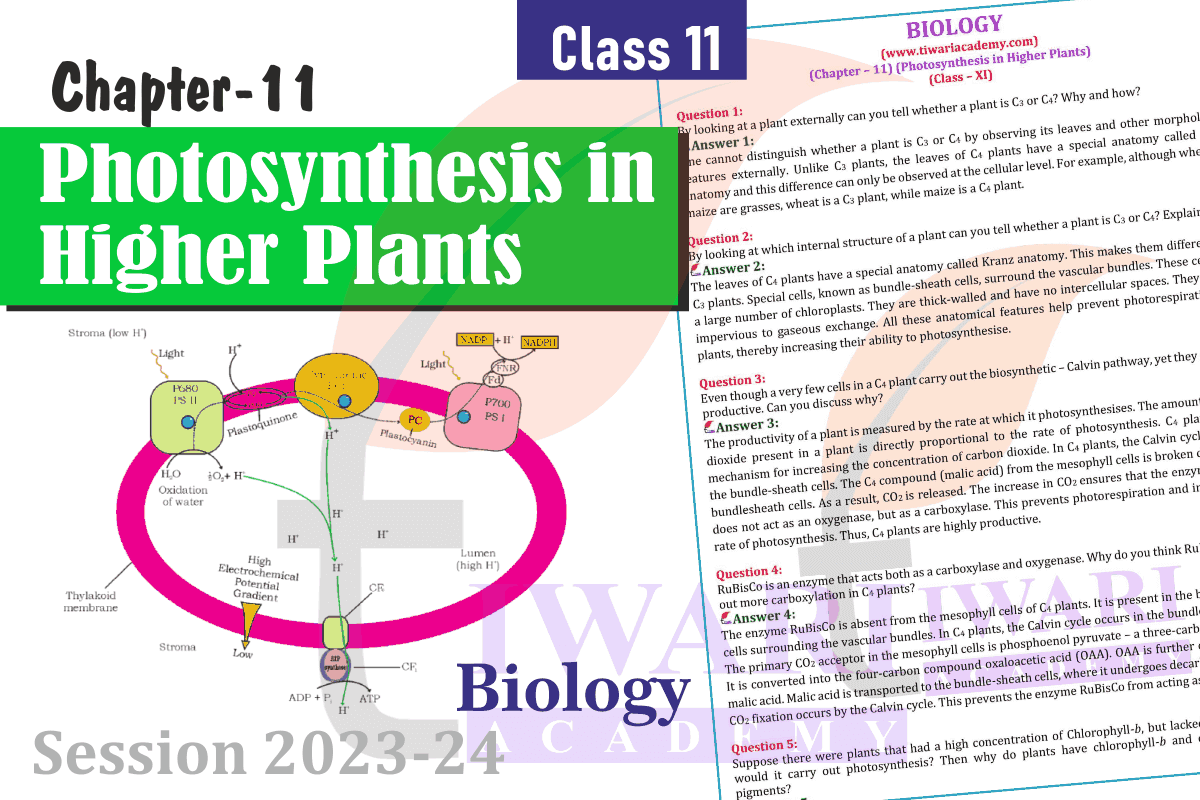
| Class: 11 | Biology |
| Chapter 11: | Photosynthesis in Higher Plants |
| Content: | Exercises and Practice Question Answers |
| Mode of Content: | Text, Videos, PDF and Images |
| Board: | CBSE and State boards |
| Academic Sesssion: | Year 2025-26 |
| Medium: | Hindi and English Medium |
Class 11 Biology Chapter 11 Solutions in English
NCERT Solutions for Class 11 Biology Chapter 11 in PDF format to free download is given below updated for new session 2025-26. Offline Apps based on NCERT Solutions 2025-26 following the latest NCERT Books are also given to free download and use offline. All the solutions are updated according to new CBSE Syllabus, if you have some problem related to education, please visit to discussion forum.
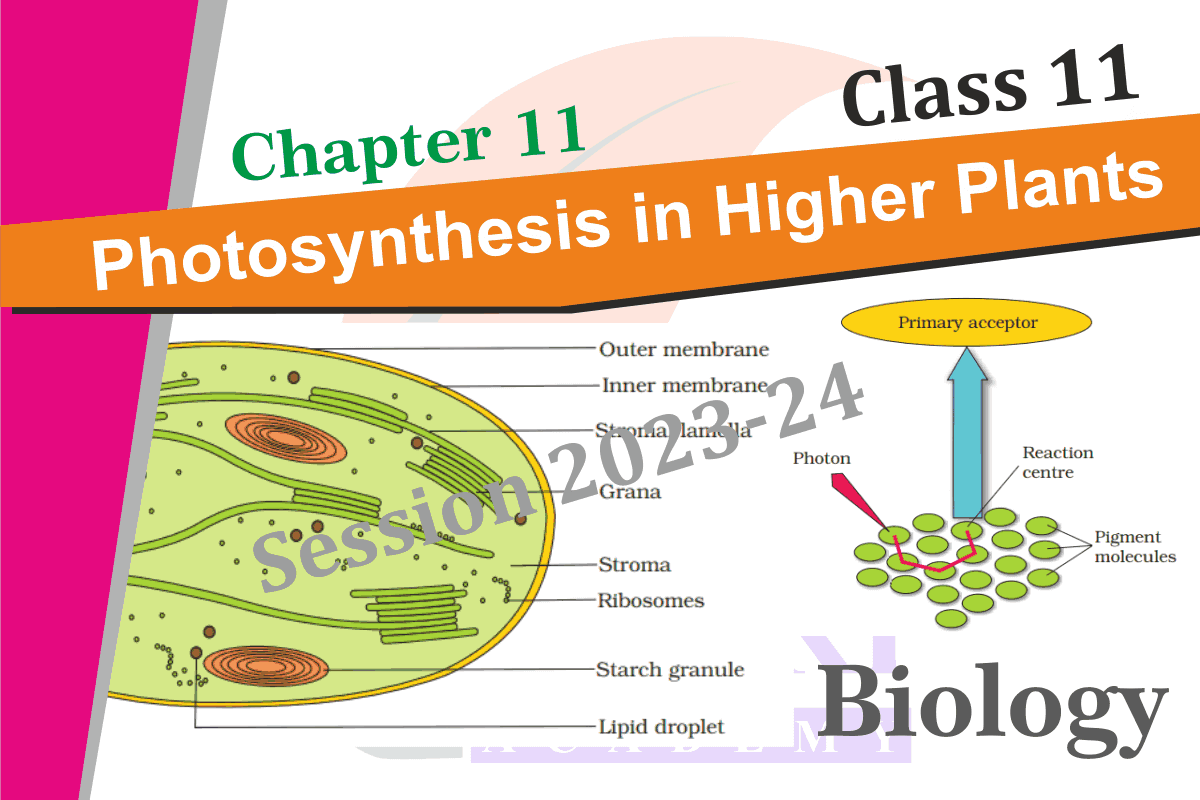
Important Notes on Photosynthesis in Higher Plants
HISTORICAL PERSPECTIVE
1. Josheph Priestley (1770): Showed that plants have the ability to take up CO2 from atmosphere and release O2. (Candle with belljar and mouse expt.)
2. Jan Ingenhousz (1779): Release of O2 by plants was possible only in sunlight and only by the green parts of plants. (Expt. with aquatic plant in light & dark).
3. Theodore de Saussure (1804): Water is an essential requirement for photosynthesis to occur.
4. Hill (1937): Evolution of oxygen occurs in light reaction.
5. Calvin (1954-55): Traced the pathway of carbon fixation.
6. Hatch and Slack (1965): Discovered C4 pathway of CO2 fixation.
7. Julius Von Sachs (1854): Green parts in plant produce glucose which is stored as starch.
8. T.W. Engelmann (1888): The effect of different wavelength of light on photosynthesis and plotted the first action spectrum of photosynthesis.
9. C.B. Van Niel (1931): Photosynthesis is essentially a light dependent reaction in which hydrogen from an oxidisable compound reduces CO2 to form sugar. He gave a simplified chemical equation of photosynthesis.
Light Harvesting Complexes (LHC)
The light harvesting complexes are made up of hundreds of pigment molecules bound to protein within the photosystem I (PS-I) and photosystem II (PS-II). Each photosystem has all the pigments except one molecule of chlorophyll–a – forming a light harvesting system (antennae). The reaction centre (chlorophyll a) is different in both the photosystems.
NON-CYCLIC PHOTOPHOSPHORYLATION
Two photosystems work in series – First PSII and then PSI. These two photosystems are connected through an electron transport chain (Z. Scheme). Both ATP and NADPH + H+ are synthesised by this process. PSI and PSII are found in lamellae of grana, hence this process is carried here.
The electron transport (Z-Scheme)
In PS II, reaction centre (chlorophyll a) absorbs 680 nm wavelength of red light which make the electrons to become excited. These electrons are taken up by the electron acceptor that passes them to an electron transport system (ETS) consisting of cytochromes. The movement of electron is downhill. Then, the electron pass to PS I and move downhill further.
Important Questions on 11th Biology Chapter 11
By looking at a plant externally can you tell whether a plant is C3 or C4? Why and how?
One cannot distinguish whether a plant is C3 or C4 by observing its leaves and other morphological features externally. Unlike C3 plants, the leaves of C4 plants have a special anatomy called Kranz anatomy and this difference can only be observed at the cellular level. For example, although wheat and maize are grasses, wheat is a C3 plant, while maize is a C4 plant.
By looking at which internal structure of a plant can you tell whether a plant is C3 or C4? Explain.
The leaves of C4 plants have a special anatomy called Kranz anatomy. This makes them different from C3 plants. Special cells, known as bundle-sheath cells, surround the vascular bundles. These cells have a large number of chloroplasts. They are thick-walled and have no intercellular spaces. They are also impervious to gaseous exchange. All these anatomical features help prevent photorespiration in C4 plants, thereby increasing their ability to photosynthesise.
Even though a very few cells in a C4 plant carry out the biosynthetic – Calvin pathway, yet they are highly productive. Can you discuss why?
The productivity of a plant is measured by the rate at which it photosynthesises. The amount of carbon dioxide present in a plant is directly proportional to the rate of photosynthesis. C4 plants have a mechanism for increasing the concentration of carbon dioxide. In C4 plants, the Calvin cycle occurs in the bundle-sheath cells. The C4 compound (malic acid) from the mesophyll cells is broken down in the bundlesheath cells. As a result, CO2 is released. The increase in CO2 ensures that the enzyme RuBisCo does not act as an oxygenase, but as a carboxylase. This prevents photorespiration and increases the rate of photosynthesis. Thus, C4 plants are highly productive.
RuBisCo is an enzyme that acts both as a carboxylase and oxygenase. Why do you think RuBisCo carries out more carboxylation in C4 plants?
The enzyme RuBisCo is absent from the mesophyll cells of C4 plants. It is present in the bundle-sheath cells surrounding the vascular bundles. In C4 plants, the Calvin cycle occurs in the bundle-sheath cells. The primary CO2 acceptor in the mesophyll cells is phosphoenol pyruvate – a three-carbon compound. It is converted into the four-carbon compound oxaloacetic acid (OAA). OAA is further converted into malic acid. Malic acid is transported to the bundle-sheath cells, where it undergoes decarboxylation and CO2 fixation occurs by the Calvin cycle. This prevents the enzyme RuBisCo from acting as an oxygenase.
Suppose there were plants that had a high concentration of Chlorophyll-b, but lacked chlorophyll-a, would it carry out photosynthesis? Then why do plants have chlorophyll-b and other accessory pigments?
Chlorophyll-a molecules act as antenna molecules. They get excited by absorbing light and emit electrons during cyclic and non-cyclic photophosphorylations. They form the reaction centres for both photosystems I and II. Chlorophyll-b and other photosynthetic pigments such as carotenoids and xanthophylls act as accessory pigments. Their role is to absorb energy and transfer it to chlorophyll-a. Carotenoids and xanthophylls also protect the chlorophyll molecule from photo-oxidation. Therefore, chlorophyll-a is essential for photosynthesis. If any plant were to lack chlorophyll-a and contain a high concentration of chlorophyll-b, then this plant would not undergo photosynthesis.
Why is the colour of a leaf kept in the dark frequently yellow, or pale green? Which pigment do you think is more stable?
Since leaves require light to perform photosynthesis, the colour of a leaf kept in the dark changes from a darker to a lighter shade of green. Sometimes, it also turns yellow. The production of the chlorophyll pigment essential for photosynthesis is directly proportional to the amount of light available. In the absence of light, the production of chlorophyll-a molecules stops and they get broken slowly. This changes the colour of the leaf gradually to light green. During this process, the xanthophyll and carotenoid pigments become predominant, causing the leaf to become yellow. These pigments are more stable as light is not essential for their production. They are always present in plants.
Look at leaves of the same plant on the shady side and compare it with the leaves on the sunny side. Or, compare the potted plants kept in the sunlight with those in the shade. Which of them has leaves that are darker green? Why?
Light is a limiting factor for photosynthesis. Leaves get lesser light for photosynthesis when they are in shade. Therefore, the leaves or plants in shade perform lesser photosynthesis as compared to the leaves or plants kept in sunlight. In order to increase the rate of photosynthesis, the leaves present in shade have more chlorophyll pigments. This increase in chlorophyll content increases the amount of light absorbed by the leaves, which in turn increases the rate of photosynthesis. Therefore, the leaves or plants in shade are greener than the leaves or plants kept in the sun.
Cyclic photophosphorylation
Only PS-I works, the electron circulates within the photosystem. It happens in the stroma lamellae (possible location) because in this region PSII and NADP reductase enzyme are absent. Hence only
ATP molecules are synthesised. It occurs when only light of wavelengths beyond 680 nm are available for excitation.
